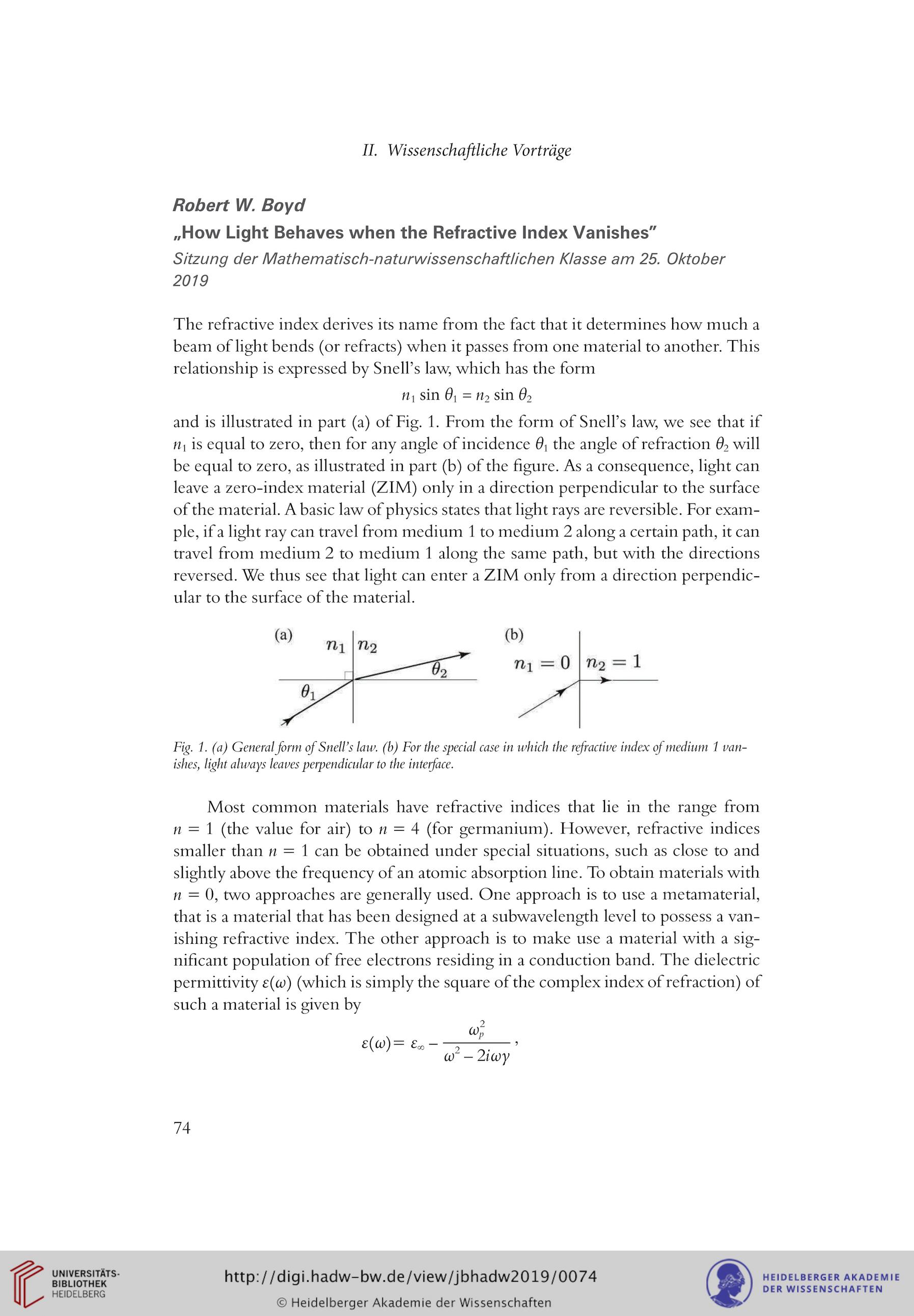Heidelberger Akademie der Wissenschaften [Hrsg.]
Jahrbuch ... / Heidelberger Akademie der Wissenschaften: Jahrbuch 2019
— 2020
Zitieren dieser Seite
Bitte zitieren Sie diese Seite, indem Sie folgende Adresse (URL)/folgende DOI benutzen:
https://doi.org/10.11588/diglit.55176#0074
DOI Kapitel:
A. Das akademische Jahr 2019
DOI Kapitel:II. Wissenschaftliche Vorträge
DOI Artikel:Boyd, Robert W.: How light behaves when the refractive index vanishes
DOI Seite / Zitierlink:https://doi.org/10.11588/diglit.55176#0074
- Schmutztitel
- Titelblatt
- Inhaltsverzeichnis
-
A. Das akademische Jahr 2019
-
11-48
I. Jahresfeier am 18. Mai 2019
- 11-12 Begrüßung durch den Präsidenten Thomas Holstein
- 13-15 Grußwort des Präsidenten der Deutschen Akademie der Naturforscher Leopoldina Jörg Hacker
- 16-21 Rechenschaftsbericht des Präsidenten
- 22-23 Kurzbericht der Sprecherin des WIN-Kollegs Daniela Mier: „JungeWissenschaft in der Akademie: das WIN-Kolleg“
- 24 Verleihung der Preise
-
49-80
II. Wissenschaftliche Vorträge
- III. Veranstaltungen
-
11-48
I. Jahresfeier am 18. Mai 2019
- B. Die Mitglieder
-
C. Die Forschungsvorhaben
- 223-224 I. Forschungsvorhaben und Arbeitsstellenleiter
-
225-331
II. Tätigkeitsberichte
- 225-228 1. Deutsche Inschriften des Mittelalters
- 229-234 2. Wörterbuch der altgaskognischen Urkundensprache (DAG)
- 234-240 3. Deutsches Rechtswörterbuch
- 240-242 4. Goethe-Wörterbuch (Tübingen)
- 242-246 5. Melanchthon-Briefwechsel
- 246-249 6. Altfranzösisches etymologisches Wörterbuch (DEAF)
- 250-255 7. Epigraphische Datenbank römischer Inschriften
- 255-260 8. Edition literarischer Keilschrifttexte aus Assur
- 261-267 9. Buddhistische Steininschriften in Nordchina
- 267-274 10. Geschichte der südwestdeutschen Hofmusik im 18.Jahrhundert (Schwetzingen)
- 275-287 11. The Role of Culture in Early Expansions of Humans (Frankfurt/Tübingen)
- 287-293 12. Nietzsche-Kommentar (Freiburg)
- 293-298 13. Klöster im Hochmittelalter: Innovationslabore europäischer Lebensentwürfe und Ordnungsmodelle (Heidelberg/Dresden)
- 299-305 14. Der Tempel als Kanon der religiösen Literatur Ägyptens (Tübingen)
- 306-310 15. Kommentierung der Fragmente der griechischen Komödie (Freiburg)
- 310-314 16. Kommentierung und Gesamtedition der Werke von Karl Jaspers sowie Edition der Briefe und des Nachlasses in Auswahl
- 314-318 17. Historisch-philologischer Kommentar zur Chronik des Johannes Malalas
- 319-325 18. Religions- und rechtsgeschichtliche Quellen des vormodernen Nepal
- 325-331 19. Theologenbriefwechsel im Südwesten des Reichs in der Frühen Neuzeit (1550–1620)
-
332-341
III. Drittmittel-geförderte Projekte
- 332-335 20. Nepal Heritage Documentation Project
- 335-338 21. Ludwik Fleck und seine ‚Denkkollektive‘: Der (Lemberger) Entstehungskontext seiner Ideen vom Denkstil und Denkkollektiv und ihre interdisziplinäre Rezeption
- 338-340 22. Individualisierung und Demokratisierung der Versorgung von Krebspatienten mittels künstlicher Intelligenz: transdisziplinäre Lösungen und normative Überlegungen
- 340-341 23. EUCANCan: a federated network of aligned and interoperable infrastructures for the homogeneous analysis, management and sharing of genomic oncology data for Personalized Medicine
-
D. Förderung des wissenschaftlichen Nachwuchses
-
I. Die Preisträger
- 343-344 Akademiepreis
- 345 Karl-Freudenberg-Preis
- 346 Walter-Witzenmann-Preis
- 347-348 Ökologiepreis der Viktor-und-Sigrid-Dulger-Stiftung
-
349-351
Manfred-Fuchs-Preis
- 349-350 Julia Burkhardt: „Von Bienen lernen. Das Bonum universale de apibus des Thomas von Cantimpré als Gemeinschaftsentwurf (Analyse, Edition, Übersetzung, Kommentar)“
- 350-351 Thomas Böttcher: „Virulenz krankheitserregender Bakterien, die Entwicklung neuer Antibiotika sowie die Untersuchung der chemischen Interaktionen zwischen Mikroorganismen“
-
II. Das WIN-Kolleg
- 352 Aufgaben und Ziele
- 353-354 Verzeichnis der WIN-Kollegiaten
-
355-385
Sechster Forschungsschwerpunkt „Messen und Verstehen der Welt durch die Wissenschaft“
- 355-357 1. Analyzing, Measuring and Forecasting Financial Risks by means of High-Frequency Data
- 358-363 2. Das menschliche Spiegelneuronensystem: Wie erfassen wir, was wir nicht messen können?
- 363-364 3. Quantifizierung in Politik und Recht am Beispiel von Wirtschaftssanktionen
- 365-368 4. Europäischer Datenschutz und Datenaustausch: interdisziplinäre Bedingungen und internationale Implikationen
- 369-372 5. CAL²Lab – Eine rechtslinguistische Experimentierplattform
- 373-375 6. „Working Numbers“: Science and Contemporary Politics
- 376-379 7. Thermischer Komfort und Schmerz – Untersuchungen zur Dynamik der Schmerz- und Komfortwahrnehmung
- 380-382 8. Charakterisierung von durchströmten Gefäßen und der Hämodynamik mittels modell- und simulationsbasierter Fluss-MRI (CFD-MRI)
- 383-384 9. Zählen und Erzählen. Spielräume und Korrelationen quantitativer und qualitativer Welterschließung
- 385 10. Metaphern und Modelle – Zur Übersetzung von Wissen in Verstehen
-
386-402
Siebter Forschungsschwerpunkt „Wie entscheiden Kollektive?“
- 386-388 11. Heiligenleben: Erzählte Heiligkeit zwischen Individualentscheidung und kollektiver Anerkennung
- 389-392 12. How does group composition influence collective sensing and decision making?
- 393-396 13. Fake News and Collective Decision Making. Rapid Automated Assessment of Media Bias
- 397-399 14. Heterogeneity and Convergence in Shared Data Sources – The Importance of Cognitive Coherence in Collective Decision Making
- 400-402 15. Ein transdisziplinäres Modell zur Struktur- und Musterbildung kollektiven Entscheidens: Synergieeffekte zwischen linguistischen, biologischen und physikalischen Ansätzen
- 403-406 III. Das Akademie-Kolleg
-
IV. Akademiekonferenzen
-
I. Die Preisträger
- 415-440 E. Anhang
- 447-455 Personenregister
II. Wissenschaftliche Vorträge
Robert l/IZ. Boyd
„How Light Behaves when the Refractive Index Vanishes"
Sitzung der Mathematisch-naturwissenschaftlichen Klasse am 25. Oktober
2019
The refractive index derives its name from the fact that it determines how much a
beam of light bends (or refracts) when it passes from one material to another. This
relationship is expressed by Snell’s law, which has the form
»i sin 0] = n2 sin 02
and is illustrated in part (a) of Fig. 1. From the form of Snell’s law, we see that if
«i is equal to zero, then for any angle of incidence 0i the angle of refraction 02 will
be equal to zero, as illustrated in part (b) of the figure. As a consequence, light can
leave a zero-index material (ZIM) only in a direction perpendicular to the surface
of the material. A basic law of physics States that light rays are reversible. For exam-
ple, if a light ray can travel from medium 1 to medium 2 along a certain path, it can
travel from medium 2 to medium 1 along the same path, but with the directions
reversed. We thus see that light can enter a ZIM only from a direction perpendic-
ular to the surface of the material.
Fig. 1. (a) General form of Snell’s law. (b) For the special case in which the refractive index of medium 1 van-
ishes, light always leaves perpendicular to the inteiface.
Most common materials have refractive Indices that lie in the ränge from
n = 1 (the value for air) to n = 4 (for germanium). However, refractive Indices
smaller than n = 1 can be obtained under special situations, such as close to and
slightly above the frequency of an atomic absorption line. To obtain materials with
ti = 0, two approachcs are generally used. One approach is to use a metamaterial,
that is a material that has been designed at a subwavelength level to possess a van-
ishing refractive index. The other approach is to make use a material with a sig-
nificant population of free electrons residing in a conduction band. The dielectric
permittivity e(o)) (which is simply the square of the complex index of refraction) of
such a material is given by
2
£(w)= £oo- o ’
o) - Zicoy
74
Robert l/IZ. Boyd
„How Light Behaves when the Refractive Index Vanishes"
Sitzung der Mathematisch-naturwissenschaftlichen Klasse am 25. Oktober
2019
The refractive index derives its name from the fact that it determines how much a
beam of light bends (or refracts) when it passes from one material to another. This
relationship is expressed by Snell’s law, which has the form
»i sin 0] = n2 sin 02
and is illustrated in part (a) of Fig. 1. From the form of Snell’s law, we see that if
«i is equal to zero, then for any angle of incidence 0i the angle of refraction 02 will
be equal to zero, as illustrated in part (b) of the figure. As a consequence, light can
leave a zero-index material (ZIM) only in a direction perpendicular to the surface
of the material. A basic law of physics States that light rays are reversible. For exam-
ple, if a light ray can travel from medium 1 to medium 2 along a certain path, it can
travel from medium 2 to medium 1 along the same path, but with the directions
reversed. We thus see that light can enter a ZIM only from a direction perpendic-
ular to the surface of the material.
Fig. 1. (a) General form of Snell’s law. (b) For the special case in which the refractive index of medium 1 van-
ishes, light always leaves perpendicular to the inteiface.
Most common materials have refractive Indices that lie in the ränge from
n = 1 (the value for air) to n = 4 (for germanium). However, refractive Indices
smaller than n = 1 can be obtained under special situations, such as close to and
slightly above the frequency of an atomic absorption line. To obtain materials with
ti = 0, two approachcs are generally used. One approach is to use a metamaterial,
that is a material that has been designed at a subwavelength level to possess a van-
ishing refractive index. The other approach is to make use a material with a sig-
nificant population of free electrons residing in a conduction band. The dielectric
permittivity e(o)) (which is simply the square of the complex index of refraction) of
such a material is given by
2
£(w)= £oo- o ’
o) - Zicoy
74




